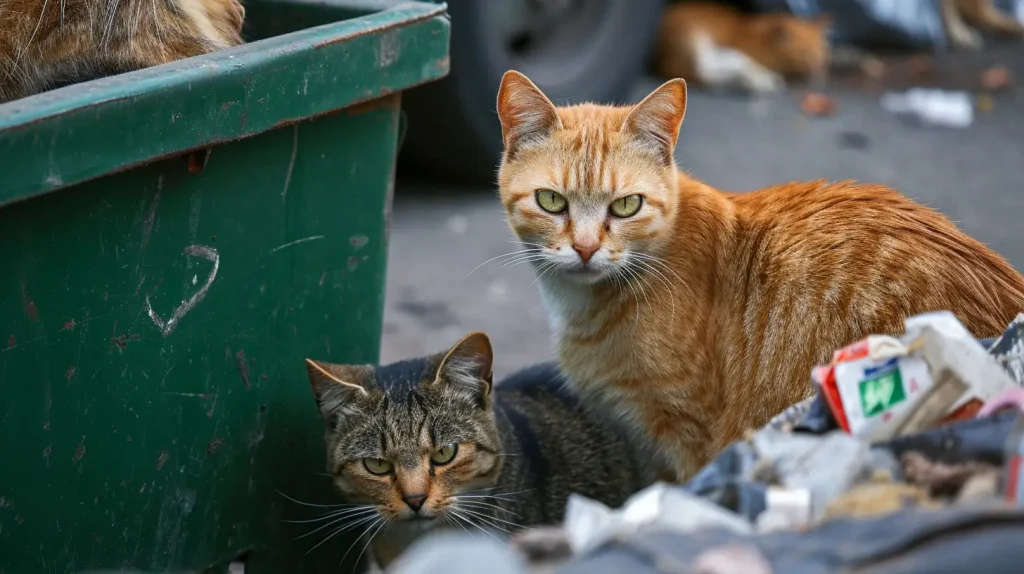Table of Contents
Seasonal changes can have a significant impact on the health, behavior, and survival of stray cats. Stray cats are already vulnerable to various environmental factors, and seasonal changes can exacerbate the challenges they face.
For instance, during the winter season, stray cats face extreme cold temperatures, which can lead to hypothermia and other health problems. In contrast, during the summer season, stray cats are exposed to high temperatures and dehydration. Understanding these seasonal variations is key to coming up with appropriate strategies to help stray cats cope with the challenges they face.
Key Takeaways
- Seasonal changes affect the health, behavior, and survival of stray cats.
- Extreme temperatures during winter and summer can cause health problems for stray cats.
- Understanding seasonal variations is crucial for developing effective strategies to support stray cat populations.
Effects of Seasons on Stray Cats
Seasonal changes can have a significant impact on the behavior and well-being of stray cats. As the weather shifts from hot to cold and back again, feral felines must adapt their habits and routines to survive. Understanding the effects of seasonal variations on these vulnerable animals is crucial for developing effective strategies to manage and care for them.
Seasonal variations and stray cat behavior:
During the summer months, stray cats are more active and may become more aggressive in their quest for food and territory. They may also be more vocal and visible, as they seek out cooler areas to rest and avoid the heat. In the winter, however, stray cats tend to become more reclusive and conserve energy to stay warm. They may also seek out warmer shelter options, such as abandoned buildings or car engines.
Effects of seasons on stray cats:
Extreme temperatures can have a significant impact on the health and survival of stray cats. In the summer, exposure to high temperatures can lead to dehydration, heat exhaustion, and sunburn. In the winter, frostbite and hypothermia are common concerns. Changes in food availability may also affect stray cat populations, as seasonal variations can impact the availability of prey or food sources.
Seasonal variations and healthcare considerations:
During the summer, stray cats are at higher risk for certain health issues, such as flea and tick infestations, infections, and skin conditions. In the winter, respiratory illnesses may be more common due to exposure to cold and damp conditions. Providing appropriate healthcare, such as vaccinations and parasite prevention, is essential for ensuring the well-being of stray cats throughout the year.
Challenges and coping mechanisms:
Stray cats face unique challenges during each season, from managing extreme temperatures to finding adequate shelter and food. They may also be vulnerable to threats from humans, such as cruelty and abandonment. However, stray cats are resilient animals and have developed coping mechanisms to help them survive. For example, some stray cats will seek out communal shelter options during the winter, while others may develop stronger social bonds with other cats to increase their chances of survival.
By understanding the effects of seasonal variations on stray cats, individuals and organizations can develop effective strategies for managing and caring for these vulnerable animals throughout the year.
Seasonal Impact on Stray Cat Health
Seasonal changes have a significant impact on the health and well-being of stray cats. Extreme temperatures, changes in food availability, and other environmental factors can affect their ability to cope with the challenges of each season. As a result, it is essential to understand the seasonal impact on stray cat health and implement appropriate interventions.
The winter months can be particularly harsh for stray cats, as they struggle to find sufficient food sources and shelter. Exposure to freezing temperatures can lead to hypothermia, frostbite, and other health issues. Conversely, the hot summer months can cause dehydration and heatstroke, putting feral felines at risk.
Fortunately, stray cats have developed several coping mechanisms to survive in these conditions. During the winter, they may seek shelter in abandoned buildings or other warm areas to stay out of the cold. In the summer, they may stay in the shade to avoid direct sunlight and conserve energy.
However, stray cats are still vulnerable to many health risks during each season. It is crucial to support them by providing food, water, and medical attention when necessary. Feeding programs can ensure that stray cats have access to regular meals and adequate nutrition. Additionally, providing clean water sources can help prevent dehydration during hot weather.
Furthermore, implementing spay and neuter programs can help manage the stray cat population and reduce the risk of disease transmission. These programs also prevent unwanted litters from adding to the already overwhelming number of stray cats.
In conclusion, understanding the seasonal impact on stray cat health is essential for providing appropriate care and support. By implementing strategies to manage and care for the feral feline population, we can ensure their survival and well-being despite the challenges of each season.
Managing Stray Cats During Different Seasons
Managing stray cats during different seasons can be challenging due to the varying environmental conditions they face. With limited access to shelter and food, stray cats must rely on their instincts to survive. It is vital to understand the seasonal challenges for the stray cat population to develop effective solutions for their management.
During the winter season, stray cats face extreme temperatures that can lead to hypothermia, frostbite, and even death. Providing insulated shelters with warm bedding can protect them from the brutal cold. Additionally, setting up feeding stations in easily accessible areas with food that has a higher calorie content can help cats maintain their body heat and weight.
During the summer season, stray cats face dehydration, heat exhaustion, and sunburn. Providing shaded areas with plenty of water sources and setting up cooling stations can help them cope with the heat. Additionally, feeding stations must be clean and well-maintained to prevent the spread of diseases.
During the spring and fall seasons, stray cats face challenges such as mating season and changes in food availability. Setting up spay and neuter programs can help control the population growth. Additionally, establishing feeding programs with a consistent supply of food can help stray cats cope with the changing seasonal food sources.
Overall, managing stray cats during different seasons requires a combination of strategies that cater to their specific needs during each period. By providing adequate shelter, food, and healthcare, the challenges that come with seasonal variations can be managed, ensuring the welfare and survival of stray cats.
Seasonal Trends and Their Effect on Stray Cats
Seasonal changes have a significant impact on the behavior and population of stray cats. Studying these trends is crucial for implementing effective long-term management strategies for stray cat populations.
The breeding season is a significant seasonal trend that affects stray cats. Typically, feral felines breed in the spring and summer months, resulting in an increase in their population during those seasons. This pattern highlights the importance of targeted spaying and neutering programs to control the stray cat population.
The migration patterns of cats are also significantly affected by seasonal changes. Some cats tend to wander more during the warmer months, while others become more sedentary during the colder seasons. These migration patterns present challenges for managing stray cat populations, particularly in rural areas where cats may travel long distances to find food and water.
Seasonal variations in climate and temperature affect the availability of food and access to safe shelter for stray cats. During the winter months, food becomes scarce, and it can be challenging for cats to find warm and dry places to take shelter. In contrast, the warmer months present challenges with dehydration and heat exhaustion due to a lack of access to clean drinking water.
To manage the impact of seasonal trends on stray cats, it is essential to develop proactive strategies that take these trends into account. Providing access to food, water, and shelter during times of scarcity can help support stray cats during challenging weather patterns. Targeted spaying and neutering programs can also help control the feral cat population, limiting the impact of seasonal breeding patterns. Finally, it is crucial to provide healthcare support for stray cats, such as vaccinations and deworming, to protect their health during times of vulnerability.
Conclusion
In conclusion, as the seasons change, so do the challenges faced by stray cats. From extreme temperatures to changes in food availability, these environmental factors can have a significant impact on the health and well-being of stray cats. It is essential to understand these seasonal variations to provide appropriate care and support for these vulnerable felines.
By implementing effective strategies such as shelter options, feeding programs, and healthcare considerations, we can ensure the survival and welfare of stray cat populations throughout the year. It is crucial to acknowledge the importance of coping with seasonal changes as a stray cat, to develop long-term solutions that consider the trends and patterns that occur with seasonal changes.
Supporting Stray Cats
Individuals and organizations can make a difference by supporting local animal shelters and rescue groups, and by participating in Trap-Neuter-Return (TNR) programs. These programs humanely trap, sterilize, and vaccinate stray cats before returning them to their communities, preventing future breeding and improving the overall health of the population.
By acknowledging the seasonal impact on stray cats and taking action to provide support and care, we can ensure a better future for these vulnerable felines. Together, we can make a difference in the lives of stray cats and help them cope with the challenges of seasonal changes.



